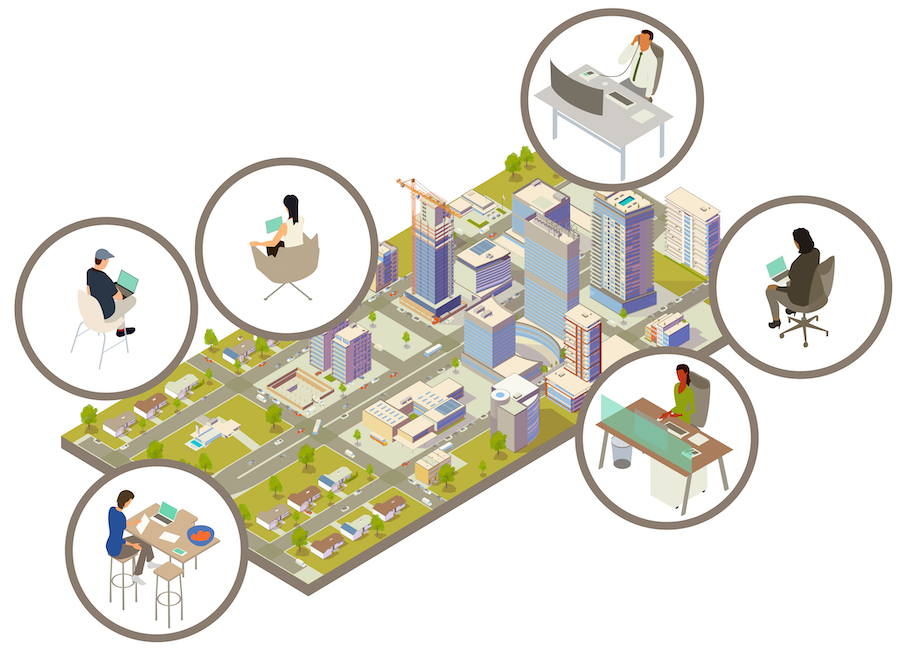Improving the Daily Flow of the Hybrid Workplace
By Bridget Castellini
April 2022
The good news is that we are on the other side of the pandemic in the sense that we’re not working in an in-flux, constantly changing state that is forcing us to quickly pivot through many unknowns. Companies are well on the way to adopting their post-pandemic workplace.
The when, where and how of the return to office has been vastly different for every workplace, including ours. Leaders recognize that it’s not one-size-fits-all and are implementing a schedule that works best for their team and business model. Our agency has put our flag in the hybrid camp — working a two-days-in-the-office, three-days-remote workweek.
Declaring an official hybrid schedule has brought a sense of normalcy, structure and the desired flexibility to our agency, but — and here’s the bad news — we are still adapting to the best ways to engage and motivate our team to stay connected.
We’re at a unique moment in time, and one that we can use to create an even better workplace and culture and improve connectivity in an environment that works for everyone.
So how do you create a sense of community and continue your agency’s culture of fostering open communication when you’re not in the same office every day? It’s not an easy endeavor, but here are six strategies you can try.
1. Survey your team on preferences and ask again.
Many of us took this step at the beginning and throughout the pandemic, but now is an even better time to ask your team again: What’s their preferred way to be contacted in the office and when they are remote?
It’s best to realign on how to reach them, especially if you need an immediate answer on something. (And in the agency world, you always do.) How do they want to be interrupted? What channel do they want you to use to ask workflow questions? Keep a running list of your teams’ preferences and ask again when you sense the need to realign.
2. Prioritize opportunities to strengthen relationships.
If you asked any of us what we missed most during remote work, it was the moments to connect before or after a meeting — walking to grab lunch or sharing a beer right after work. Time may be tight on the days you are back in the office so make sure you are prioritizing opportunities for the team to be together and build community.
We’ve learned those moments can happen at the beginning or end of a meeting and can be built into a weekly staff meeting. (We often end our meetings with a fun question.) Even on the days we’re remote, we will meet a co-worker for lunch at a convenient place, and we still use Zoom to connect face-to-face with co-workers on the days we’re not in-person.
3. Remember that you still need to pivot.
A desire for a flexible schedule is the reason why we’ll likely not return to being in the office five days a week, but with that flexibility comes a reminder that you still need to occasionally pivot. Sometimes meeting requests from clients don’t happen on the days we’re scheduled to be in the office — and that’s OK. Some weeks we’re in the office more than we want to be; other weeks we’re remote more.
Having an open conversation with your team about it, especially when it’s swinging more in a direction they don’t like, is critical to keeping everyone happy.
4. Make time to share meaningful feedback.
Our agency has always fostered a culture of feedback and open communication. During the pandemic, we placed an emphasis on how we delivered feedback remotely and worked hard to make sure it continued.
The emphasis on feedback needs to be prioritized in a hybrid environment. It’s easy to default to sending an email — don’t do it. Carve out time to have a meaningful conversation. Our open communication has helped us spot when employees are struggling so we can then engage in some appropriate dialogue.
5. Ask how well the schedule is working and ask again.
There isn’t a playbook for the hybrid workplace. Before we moved from one day in the office to two days in the office, we asked our team how they were feeling and what concerns they had. We learned we had to make the move gradually.
Now that the schedule is set, it’s important to keep checking in with the team and asking them how well it’s working for them. If it’s not, what would work better?
6. Foster open, empathetic dialogue.
Our culture has always prioritized compassion in the workplace — and we hire leaders who embrace these values. Our team knows that they can go to leadership when they are having an issue with a client as well as with personal struggles they are comfortable sharing. Keeping connections in place with our team before, throughout and post-pandemic had made these conversations easier. This is important now more than ever.
What have you discovered that helps your team? Drop me a line at: bcastellini@wordsworthweb.com.



